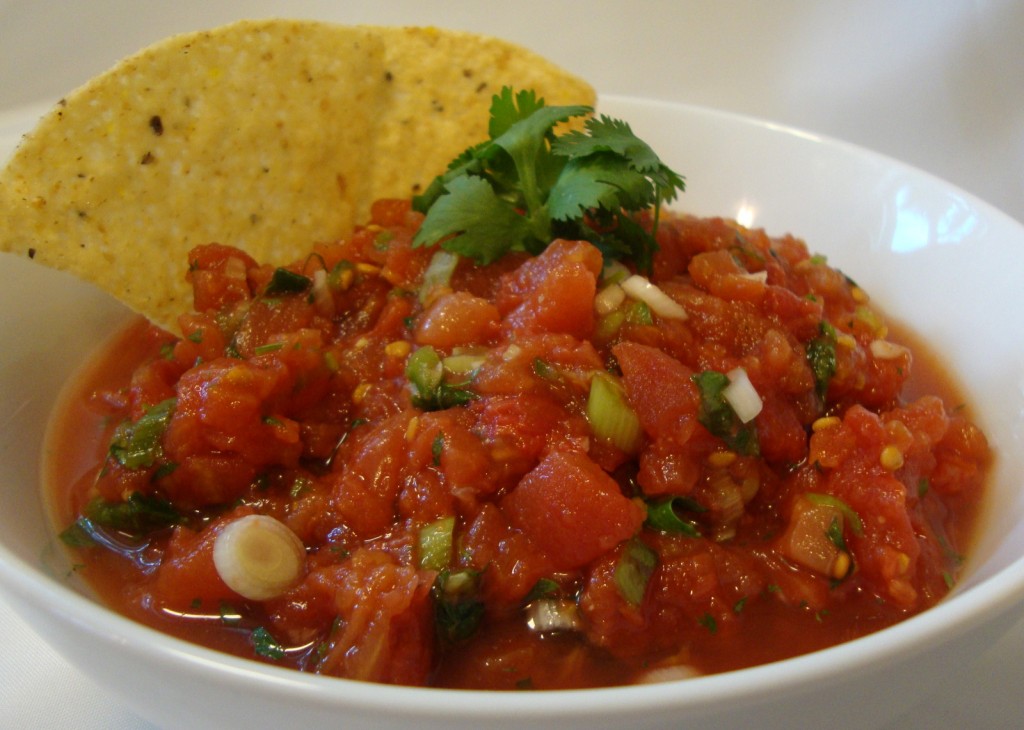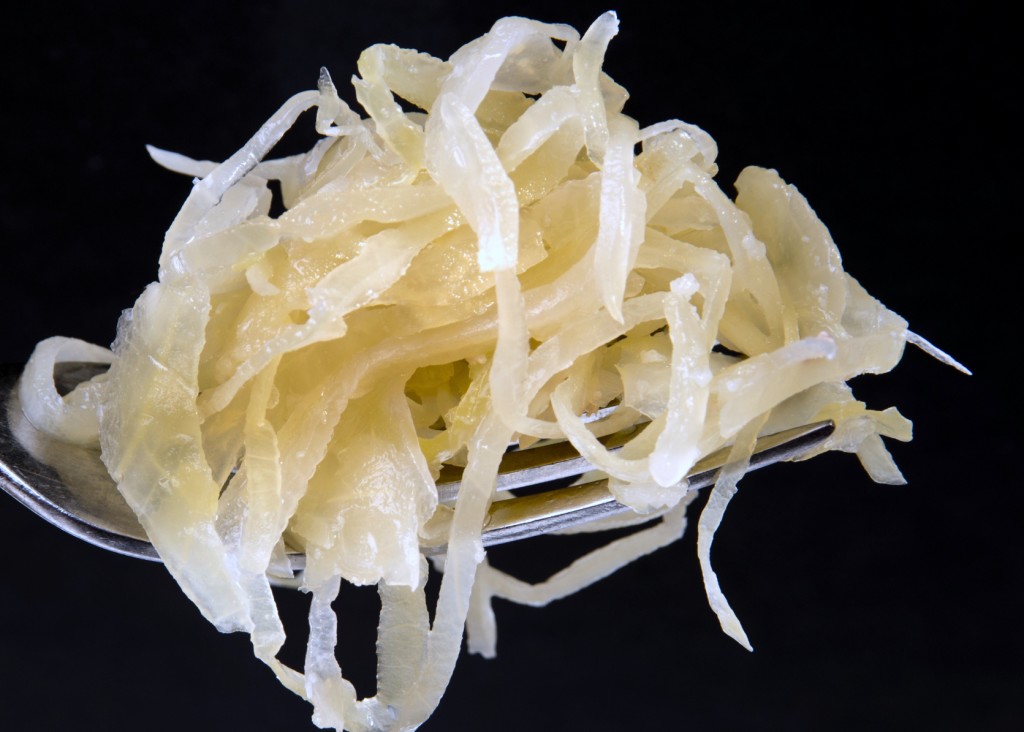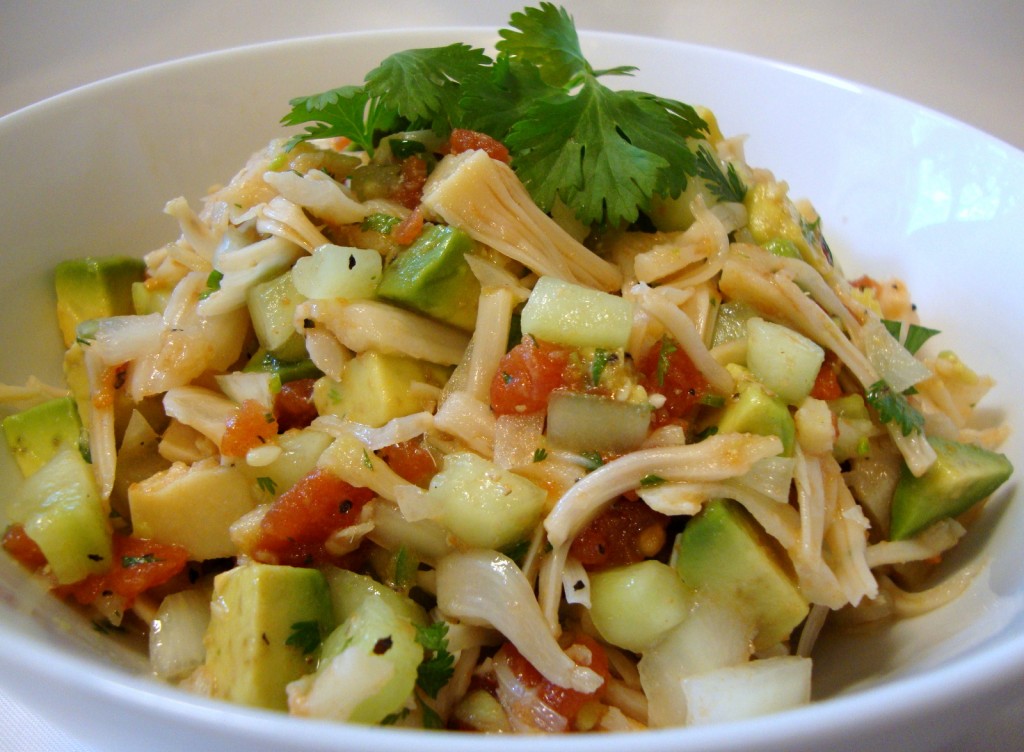 Ceviche (pronounced “seh-VEE-chay”) is a Latin American dish which traditionally consists of raw fish or shellfish marinated in citrus juice (usually lime and/or lemon juice). The acid in the citrus juice coagulates (denatures) the proteins in the seafood, effectively cooking it. Since no heat is used, the dish is served cold. There are many recipe variations combining the marinated fish/shellfish with a wide variety of other fresh ingredients such as onion, tomato, cilantro, chili peppers and avocado.
Ceviche (pronounced “seh-VEE-chay”) is a Latin American dish which traditionally consists of raw fish or shellfish marinated in citrus juice (usually lime and/or lemon juice). The acid in the citrus juice coagulates (denatures) the proteins in the seafood, effectively cooking it. Since no heat is used, the dish is served cold. There are many recipe variations combining the marinated fish/shellfish with a wide variety of other fresh ingredients such as onion, tomato, cilantro, chili peppers and avocado.
My plant-based version relies upon cooked unripe green jackfruit as a replacement for the fish/shellfish, since it has a neutral flavor which takes on the flavor of the marinade and a flaky texture reminiscent of cooked crab. The dish is essentially a zesty, marinated plant-based salad which is served cold as a refreshing appetizer with crispy corn tortilla chips. This recipe yields enough ceviche for 2 to 3 guests; for more simply multiply the recipe.
Ingredients:
• 1 can (20 oz) green jackfruit in water or brine
• ½ cup peeled and small diced tomato
• ½ cup peeled, seeded and small diced cucumber
• ¼ cup small diced onion
• ¼ cup chopped cilantro
• 1 clove garlic, minced
• 1 small Serrano chili, seeded and finely minced
• juice of 1 lime
• 1 T olive oil
• ½ tsp fine sea salt or kosher salt, or more to taste
• ¼ tsp coarse ground black pepper
• ¼ tsp ground cumin
• ½ ripe but firm avocado, diced
*Canned green jackfruit bears a resemblance to flaked crabmeat when cooked. It can be found in Indian and Asian markets or purchased through the internet. Look for the label “Green Jackfruit” or “Young Green Jackfruit” and be sure that it’s packed in water or brine and not syrup. Cans of ripe jackfruit packed in syrup may be stocked nearby, but don’t be tempted to substitute as the ripe fruit will be too sweet for this application.
Chef’s note: Traditional ceviche made with fresh seafood has a fresh, clean flavor and should not be fishy. If you wish to add a subtle ocean flavor to this plant-based version, add a little bit of dried kelp flakes or flaked, toasted nori.
Technique:
Drain the jackfruit and rinse. If the jackfruit was canned in brine, rinse thoroughly. Add the chunks of jackfruit to 1 quart salted boiling water. Reduce the heat to a slow boil and cook for 15 minutes. Drain in a colander and let cool. When cool enough to handle, remove the tough core from each chunk of jackfruit with a sharp knife and discard. Break the chunks apart with your fingers and remove the soft seeds and seed membranes and discard. The remaining flaky pulp is the only portion you will want to use in the dish, so sort through the chunks carefully (there will be a significant amount of unusable material). Wrap the pulp in a lint-free kitchen towel and squeeze to remove excess water. Coarsely chop the pulp and place in a mixing bowl.
Add the remaining ingredients EXCEPT for the avocado and toss well to combine. Refrigerate for several hours to marinate the ingredients and blend the flavors. Add the diced avocado just before serving and toss well. Season the ceviche with additional salt as desired and to taste. Serve with crunchy tortilla chips.
Votes: 4
Rating: 3.25
You:
Rate this recipe!
|
|
Votes: 4
Rating: 3.25
You:
Rate this recipe!
|
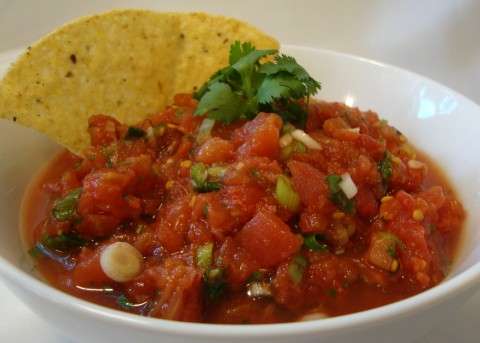
This fresh chunky garden salsa has a medium heat which can be adjusted to suit your taste. I chose canned whole tomatoes because they are partially stewed during the canning process, thus producing a superb texture for salsa. It’s very easy to make and so much better than store-bought. This recipe yields about 4 cups.
Ingredients:
• 2 cans (28 oz each) whole tomatoes
• 3 large scallions or 6 small scallions, white and green parts, finely chopped
• 2 large cloves garlic, finely minced (or 1 for timid palates)
• juice of 1 lime
• 1 small Serrano or jalapeno pepper, finely minced (about 1 T), or more to taste
(for a fiery salsa try including the seeds; for a milder salsa reduce or omit)
• ¼ cup chopped cilantro, or more to taste
• ¾ tsp fine sea salt or kosher salt, or more to taste
• ½ tsp ground cumin
Technique:
Remove the tomatoes from the can and finely dice, reserving any juice in the can for other uses, if desired. The tomatoes themselves contain a great deal of juice, so use a cutting board with irrigation channels if you have one; if not, dice 1 or 2 tomatoes at a time. Place the diced tomatoes in a mixing bowl and toss together with the remaining ingredients. Refrigerate for several hours to blend the flavors, ideally overnight.
Taste and add additional salt before serving, as desired. The salsa will keep for about 10 days in the refrigerator. Serve with your favorite tortilla chips; or use as a topping for your favorite Mexican or Tex-Mex recipes.
Print Recipe
Chef’s Favorite Garden Salsa
Votes: 0
Rating: 0
You:
Rate this recipe!
|
|
Votes: 0
Rating: 0
You:
Rate this recipe!
|
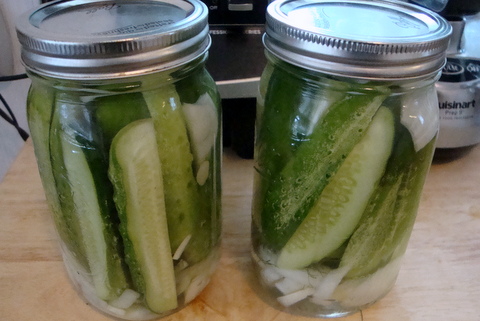
These easy-to-make pickles are fresh, crisp, tangy and nicely seasoned. The amount of brine is sufficient for preparing 2 quarts of pickles.
Ingredients:
• cucumbers, any variety, but pickling cucumbers are best
• 1 large onion, thinly sliced
• 3 cups filtered water
• ½ cup champagne vinegar or white vinegar
• 3 T sea salt or kosher salt
• 1 T organic sugar
• 2 T minced garlic (6 cloves)
• 2 T fresh chopped dill
• 1 tsp whole coriander seeds (optional)
• 1 tsp whole peppercorns or ½ tsp red pepper flakes (optional)
• 2 bay leaves
Technique:
In a bowl or large measuring cup, dissolve the salt and sugar in the vinegar and water to create the brine. Add the onion, garlic, bay leaves, dill and optional coriander seeds and pepper to a large container with a lid, or divide among 2 mason jars.
For smaller cucumbers, such as pickling cucumbers, leave unpeeled and slice in half or quarter lengthwise. For larger salad cucumbers which have tougher skins, use a vegetable peeler to cut strips of peel away, leaving some of the peel intact. This gives the cucumbers a nice variegated appearance; then cut into ¼ to ½-inch crosswise slices.
Stand the spears upright or layer the slices in the 2 jars. If using a large container, lay the spears on their side or layer the slices.
Pour the brine over the cucumbers, submerging them completely. Cover tightly. Refrigerate for a minimum of 72 hours, but the longer they “pickle”, the better. Enjoy!
Print Recipe
Refrigerator Pickles
Votes: 0
Rating: 0
You:
Rate this recipe!
|
|
Votes: 0
Rating: 0
You:
Rate this recipe!
|
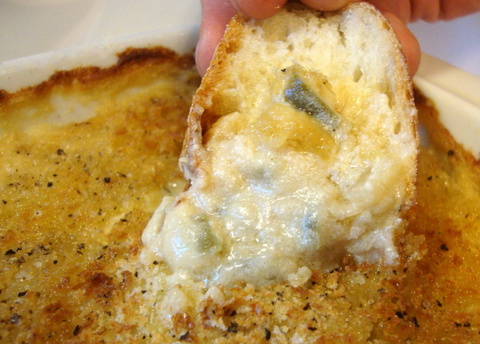
A zesty and cheesy Southwestern bean dip served hot with your favorite chips or bread for dipping.
Ingredients:
• 1 can (15 oz) or 2 cups cooked white beans (cannellini, navy or Great Northern)
• mild-flavor cooking oil
• 3 large jalapenos, seeded and diced
• 1 large Anaheim chili, seeded and diced or 1 can (4 oz) diced mild green chilies
• ½ medium onion, diced
• 3 cloves garlic, minced
• 1 and ¾ cup non-dairy milk (soymilk works best)
• ¼ cup tapioca flour (starch)
• 2 T nutritional yeast flakes
• 1 T mellow white miso paste
• 2 tsp fine sea salt or kosher salt
• 2 tsp lactic acid powder or 2 T fresh lemon juice
• 2 tsp apple cider vinegar
• ½ cup panko bread crumbs or plain, dry breadcrumbs
*Note: Use protective gloves when handling jalapeno peppers; or wash your hands thoroughly several times after handling.
Technique:
If using canned beans, rinse thoroughly until all traces of foam disappear. Drain well and set aside.
Preheat the oven to 375°F. Grease a small, shallow baking dish with cooking oil and set aside.
Add 2 tablespoons of cooking oil to a skillet and place over medium-low heat. Add the jalapeno, fresh Anaheim chili, onion and garlic with a pinch of salt and “sweat” the vegetables until softened (if using canned mild green chilies, set aside for later).
If using canned green chilies, add them at this time. Increase the heat to medium and sauté until any liquid has evaporated and the onions are translucent and lightly golden – do not brown. Transfer to a mixing bowl to cool.
In a small saucepan, whisk together the non-dairy milk, tapioca flour, nutritional yeast, miso, salt and acids. Whisk in 2 tablespoons of cooking oil and place over medium-low heat. Cook, stirring frequently, until the mixture is hot, cheesy, bubbly and smooth (the cheese sauce will be somewhat salty at this stage but will balance out when mixed with the bean purée and vegetables). Keep warm over low heat.
Place the white beans into a food processor and process into a paste. Alternately, mash the beans thoroughly with a potato masher or ricer. Transfer to the mixing bowl.
Add the cheese mixture to the mixing bowl and stir all ingredients thoroughly. Transfer to the greased baking dish, spread evenly and top with the panko crumbs. Season the topping with coarse ground black pepper and mist with cooking oil spray. The oil will help the crumbs brown in the oven.
Place on the middle rack of the oven and bake uncovered for 45 to 50 minutes or until browned and bubbly. To enhance browning if necessary, place under the broiler for about 1 minute.
Serve hot with warm tortilla chips, chunks of crusty bread or crackers. The dip will be saucy when very hot but will thicken substantially as it cools.
Print Recipe
Cheesy Jalapeno Popper Bean Dip
Votes: 2
Rating: 5
You:
Rate this recipe!
|
|
Votes: 2
Rating: 5
You:
Rate this recipe!
|
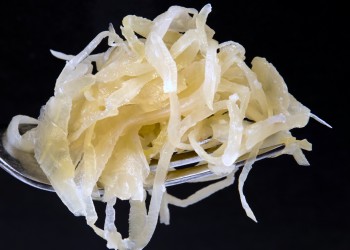
Sauerkraut is German for “sour cabbage,” but is originally a Chinese invention made with rice wine. Sauerkraut is made from finely cut cabbage that has been fermented by various lactic acid bacteria which propagate naturally during the fermentation process. It has a long shelf-life and a distinctively sour flavor, both of which result from the lactic acid that forms when the bacteria ferment the sugars in the cabbage.
Every chef has their own recipe for preparing sauerkraut and this is my personal formula and technique that works for me every time – with no undesirable mold blooms to skim from the surface of the brine during fermentation. Sauerkraut takes roughly 5 to 6 weeks from start to finish, so plan ahead and be patient – the results are worth waiting for.
Ingredients:
• 2 large heads green or red cabbage
• 3 T sea salt, kosher salt or pickling salt
• 3 cups filtered or spring water
• 1 T dried juniper berries (optional)
• 2 tsp caraway seeds (optional)
You will also need:
• 1 gallon wide-mouthed clear glass jar
• cheesecloth
• 2 one-quart zip-lock bags
• plastic wrap
Technique:
Before beginning, make sure the jar has been washed thoroughly with hot, soapy water and rinsed well; or run through the heated cycle in a dishwasher. Wash your hands thoroughly.
In a small saucepan, add 3 cups spring or filtered water and 1 teaspoon of the salt. Bring to a brief boil and remove from the heat to cool until lukewarm.
Remove any loose and damaged leaves from the heads of cabbage and either discard the leaves, save for preparing stock or compost. Split the heads of cabbage lengthwise (from the crown to the core). Cut a “V” shape to remove the tough core from each half.
Place a half head, cut side down, on a clean work surface and using a very sharp knife, begin to slice or “shave” the cabbage as thinly as possible to create very thin, long ribbons. Take your time slicing the cabbage, as very fine shreds will yield the best texture in the finished sauerkraut (personally, I use only the long, thin ribbons for the sauerkraut and save any pieces that are too large or too small for vegetable stock).
Place the shreds into the jar and sprinkle in 2 teaspoons of the salt. Repeat shredding the second half and place in the jar. Sprinkle again with 2 teaspoons salt. Using a potato masher or similar object, pack down the cabbage as firmly as possible. The salt will help draw out the juice from the cabbage to create the brine. If using the juniper berries and/or caraway seeds, sprinkle half over the cabbage.
Repeat with the second head of cabbage, adding 2 teaspoons of salt for each shredded half added to the jar. Pack down the cabbage again. If using the juniper berries and/or caraway seeds, sprinkle the remaining portion over the cabbage.
Fold a double layer of cheesecloth in half and cut to fit into the jar with some excess for tucking. Place on top of the cabbage shreds and using a dull table knife, tuck the cheesecloth snugly around the inner circumference of the jar. This will hold the shreds in place and keep them from floating upwards in the brine. Pour the cooled salted water over the cheesecloth.
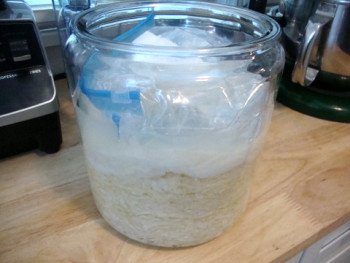
Fill a zip-lock bag about ⅔-full of water and seal. Tuck the bag into the second zip-lock bag and seal. The second bag will ensure that no leaks of water occur from the water-filled bag.
Place the water-filled bag into the jar on top of the cheesecloth. The weight of the bag will keep the mass of cabbage completely submerged in the brine during fermentation. If the cabbage is submerged completely, no undesirable mold blooms will occur. Seal the top of the jar with plastic wrap to prevent evaporation of the brine.
Place the jar in a cool place (a basement or cool pantry being ideal). A room temperature of 68 to 72 degrees is best for fermenting cabbage. Formation of gas bubbles after a few days indicates fermentation is taking place. Mark your calendar for 5 to 6 weeks.
Once a week, check the jar. The formation of gas bubbles will sometimes cause the packed shreds to rise in the jar, which can potentially expose the surface to air, thus encouraging undesirable mold blooms. Simply remove the plastic film and re-tuck and push the cheesecloth down around the inner circumference with the edge of a spoon. There’s no need to remove the bag of water; simply work around it (but be careful not to puncture the bag!). Re-seal the top of the jar with plastic wrap.
When fermentation is complete, pack individual mason jars with the sauerkraut and add enough brine to keep the shreds covered with the liquid, while leaving ½-inch of headspace in the jar. Fully fermented sauerkraut can be kept tightly covered in the refrigerator for a few months. The sauerkraut can be eaten raw, which promotes a healthy intestinal flora; or it can be cooked and used in your favorite recipe.
Print Recipe
Raw Sauerkraut
Votes: 0
Rating: 0
You:
Rate this recipe!
|
|
Votes: 0
Rating: 0
You:
Rate this recipe!
|
 Ceviche (pronounced “seh-VEE-chay”) is a Latin American dish which traditionally consists of raw fish or shellfish marinated in citrus juice (usually lime and/or lemon juice). The acid in the citrus juice coagulates (denatures) the proteins in the seafood, effectively cooking it. Since no heat is used, the dish is served cold. There are many recipe variations combining the marinated fish/shellfish with a wide variety of other fresh ingredients such as onion, tomato, cilantro, chili peppers and avocado.
Ceviche (pronounced “seh-VEE-chay”) is a Latin American dish which traditionally consists of raw fish or shellfish marinated in citrus juice (usually lime and/or lemon juice). The acid in the citrus juice coagulates (denatures) the proteins in the seafood, effectively cooking it. Since no heat is used, the dish is served cold. There are many recipe variations combining the marinated fish/shellfish with a wide variety of other fresh ingredients such as onion, tomato, cilantro, chili peppers and avocado.


